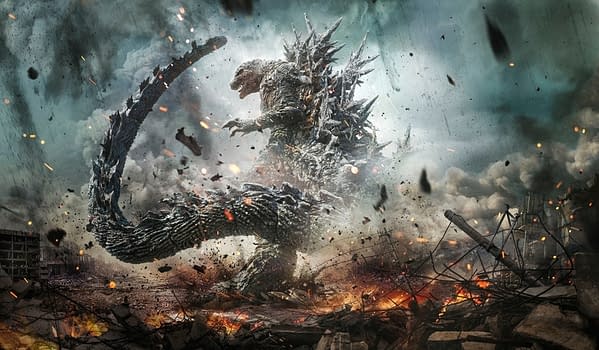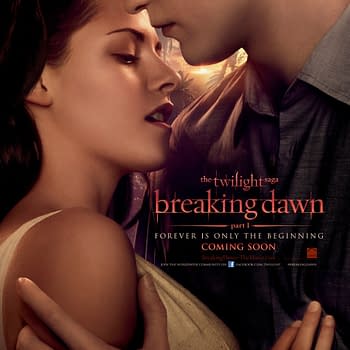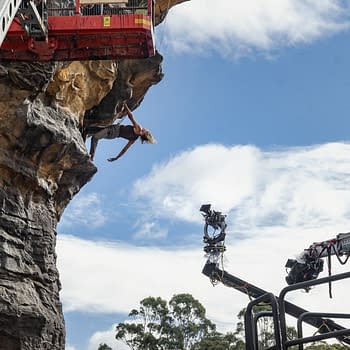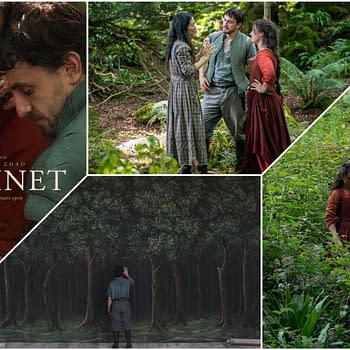Posted in: Movies, Review | Tagged: film, godzilla, Godzilla Minus One, Review, Toho
Godzilla Minus One is Modern Masterpiece (REVIEW)
Godzilla Minus One discovers a new, gripping path to success in what could be considered the best entry of the franchise.
Article Summary
- Takashi Yamazaki's ambitious vision elevates Godzilla Minus One to franchise best.
- The film offers deep human connection amidst a wartime setting, transcending its genre.
- Godzilla's evolution and detailed visual effects create a terrifying on-screen presence.
- New approaches and themes in Godzilla Minus One refresh the iconic franchise for fans.
Godzilla is back, and as expected, the timeless Kaiju is continuing its winning streak with yet another spectacular appearance in TOHO's newest iteration titled Godzilla Minus One. With filmmaker Takashi Yamazaki stepping into a multi-faceted role as the director, writer, and visual effects lead, audiences are really getting to see a skilled filmmaker's ambitious vision brought to life in what could easily be considered the strongest Godzilla film to date.

Unmatched Character-Driven Stories
In Godzilla Minus One, the titular monster's presence is entirely effective, with the legendary Kaiju getting more than enough material to be perceived as a worthwhile character in this epic tale. However, the new Japanese title learns from the mistakes of its former Godzilla franchise critiques by digging deeper and fleshing out its human characters with a heart-wrenching, tangible wartime setting.
With its central characters going through their incomparable forms of loss and relentless trauma leading up to Godzilla's first major appearance, there's an immediate sense of reality that Godzilla Minus One creates, pivoting from some of the more carefree characters across the franchise's rich and sometimes lighthearted history. By making the story focus on the unsettling terror and aftermath of war (before the kaiju terror that's about to kick off), the film forces audiences to disregard their typical 'monster-smash' inclinations to look at the sheer devastation left in its path. Which, considering that many modern moviegoers generally appear unphased by fictional destruction in big-budget flicks, it's even more impressive that Yamazaki can construct a grounded perspective that's impossible to forget.
As the film progresses, a few unexpected twists and turns ultimately showcase its remarkable ability to further navigate the most complex layers of grief and trauma in a sci-fi monster movie setting. You genuinely can't help but root for these characters, not only to survive but to overcome and eventually find some sense of peace. So, with performances from well-equipped actors like Minami Hamabe and Ryunosuke Kamiki at the forefront, these stories easily reach their full, impactful potential.
Godzilla's Terrifying On-Screen Evolution
As you likely know by now, Godzilla is generally an easy character to root for. In fact, over time, he's been repeatedly depicted as a savior to humanity to embrace those who want to see a kaiju that's capable of something other than causing complete havoc. For Godzilla Minus One, the titular character is now a primary villain to humanity once again (despite his forced re-awakening), efficiently succeeding at regaining Godzilla's status as a feared creature that rivals Jaws-level discomfort above all.
Throughout its runtime, there are several scenes where we witness even the slightest inclusion of Godzilla (limiting his body to the water or partially covered by buildings). Still, when they choose to show the creature through its framing and visual effects, there's such fierce attention to detail – from his spiney-redesign to his unsettling gaze, resulting in peak horror for the Godzilla universe. When it eventually comes to the creature's fully-evolved reveals on land or the film's unforgettable, climactic water sequences, every piece of the beloved monster's presence results in some of the franchise's eeriest depictions to date, surpassing a bar once set by Shin Godzilla.
A Franchise Entry That Doesn't Rely on the Past
When you have a property that's been around for decades (or nearly 70 years, like Godzilla), there's a higher chance that films will begin to recycle ideas or stick to a specific formula. But after years of celebrating classic foes and returning titan-esque characters, it's wholeheartedly satisfying to witness TOHO's desire to reintegrate Godzilla into new, uncharted territory by taking a few big swings.
While the movie does capture some of the magic of the earlier entries in the '50s and '60s (or even later Western iterations), there are enough stylistic changes to make it feel like something that honors previous Godzilla adventures without actually attempting to retread material as witnessed in long-term properties like Star Wars or Indiana Jones. Fortunately for both devoted franchise fans and the casual moviegoer, Godzilla Minus One's choice to tackle a devastating era while daringly stripping the character of his titan-foes reiterates that aged franchises really can learn new tricks.












